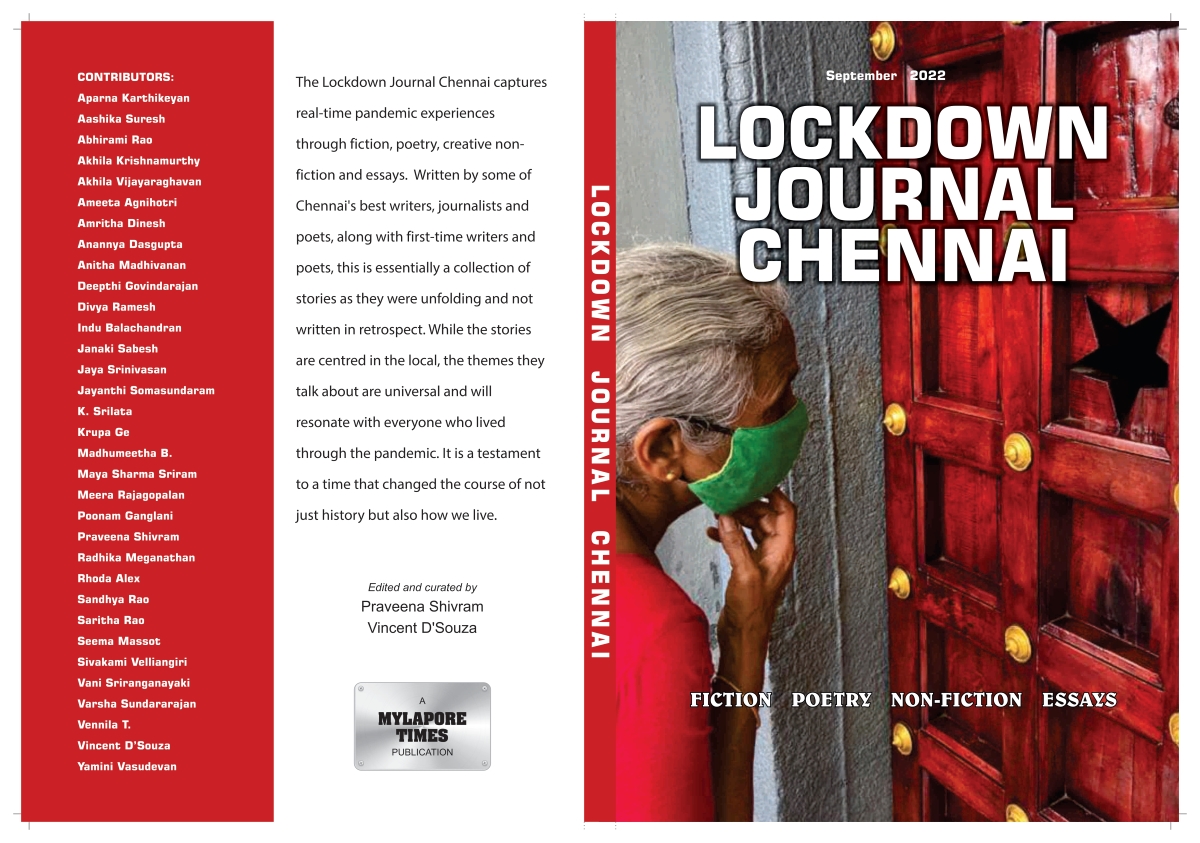Guiding the contributors in a social cause are journalists from a popular hyperlocal neighbourhood weekly.

The cover of Lockdown Journal Chennai.
Vincent D’Souza, 62, demands a professional and ethical approach from his team at the neighbourhood weekly he heads in Chennai as its founder-publisher.
It is this approach that kept his publication going during the lockdown, and it is this approach that prompted him to launch a social initiative to keep isolated people engaged during the pandemic.
The initiative involved getting writers from Chennai — both amateur and professional — to share their pandemic experiences through their writings, which D’Souza has now brought out in a book form.
“Whether it is a cyclone, rain, famine or a pandemic, we are experts in covering day-to-day affairs for our loyal readers,” says the veteran journalist of his small team of “1.5 people”.
Coastal Chennai is familiar with rain and cyclones, and the famine D’Souza talks of is a figure of speech. The pandemic was neither; it was as unexpected as it was real, but had to be dealt with.
D’Souza dealt with the situation his way: He refused to see the pandemic as a setback for his publication Mylapore Times.
So when the lockdown was declared in March 2020 and he was forced to stop printing his paper for a few months, he did not ditch its readers; instead, D’Souza decided to go online.
“We are a professionally-run newspaper and stick to journalistic ethics,” he explained to South First recently.
When Mylapore Times was started in 1994, targeting residents of the Chennai neighbourhoods of Mylapore, Mandaveli, RA Puram, Alwarpet, San Thome and Abhiramapuram, its USP was hyperlocal reportage.
Over the past 26 years, the weekly has come to be loved by its patrons for covering stories that are often missed by the mainstream media outlets.
D’Souza’s team trod the same route during the lockdown, ensuring a regular flow of reports on the state of the people in isolation.
There were stories of grief and of hope, and they kept the readers riveted.
For instance, when a community of 250 people living in 52 apartments off RK Mutt Road were at the forefront in managing their day-to-day affairs without spreading the infection, their story was covered by Mylapore Times.
That story described how security guards were fed through the day as they had been asked to stay on campus. Residents took turns to provide them food. Also, senior citizens who had stop calling in their maids and cooks were provided lunch and dinner by neighbours.
Or when the Archbishop of the San Thome Cathedral started to webcast the holy mass, it got space in the weekly.
Over a hundred such heart-warming, community-driven efforts got the coverage they rightfully deserved. Accompanying photographs added colour to the stories.
“We now have an archive of 10,000 pictures taken by our photographer over two years of the pandemic,” D’Souza says proudly.
Mylapore Times is back in the print form from mid-January 2021, the bleak pandemic days behind it for now.
But it was during those bleak times, when there was a lack of normal human interaction, that D’Souza was inspired to do something other than bring out Mylapore Times.
This was the social initiative; called Lockdown Journal Chennai, it was an online publishing portal featuring literary contributions from Chennai-based writers, on their experiences during the pandemic.
Going through the flood of fiction, poetry, creative non-fiction and essays that poured in, and curating them was the writer Praveena Shivram, who began her career at Mylapore Times in 2004, and still contributes.
Initially, the selected stories were published on the online platform Medium. Selection was based “purely” on themes, says Shivram.
For instance, if the team received a story or essay on travel, then a conscious efforts was made not to repeat that theme anywhere else in the journal.
“There was also a distinct Madras-ness to the stories, and it was not only by virtue of the writers being from Madras, but something inherent in the flavour of the words themselves,” she says.
“Almost like smelling the city even when one is not from there.”
A year after the Lockdown Journal Chennai was closed for submissions, D’Souza and Shivram pondered over a question: Should the selected writings be converted into a book?
“I love print,” laughs D’Souza, a journalist since 1980, explaining why he was so smitten by the idea. “There is nothing like print, so we decided to compile everything into a book.”
For Shivram, who edited all the contributions, this felt right because “the world had reached a point where Covid-19 became a normal part of our vocabulary and existence, and suddenly, the stories we had collected, felt historic”.
She is candid enough to describe herself as “old school” who was not convinced that online is better because it reached more people.
“I feel the physical copy lasts longer and therefore reaches more people. And reaches them not as numbers, but reaches them as people,” Shivram told South First.
“It stays on our shelves, in our rooms, by our bedside tables. And in our deepest moments of need, it speaks to us. That, to me, is reach.”
The submissions were published as a book titled Lockdown Journal Chennai, and released at Ranade Library on Luz Church Road in the Mylapore neighbourhood in March 2023.
The book cover explains that while the stories are “centred in the local”, the themes they talk about are universal, and will resonate with anyone who lived through the pandemic.
“It is a testament to a time that changed the course of not just history but also how we live,” it says.
D’Souza himself has contributed two stories for the journal, one of them based on the fishing community living by the Marina Beach.
And he doesn’t mince his words while assessing his work.
“I love the stories I did,” he says.

Jul 26, 2024

Jul 25, 2024

Jul 21, 2024

Jul 21, 2024

Jul 21, 2024

Jul 21, 2024